Experiments at Demolition of Old Washington Convention Center Aim to Improve First Responder Communications
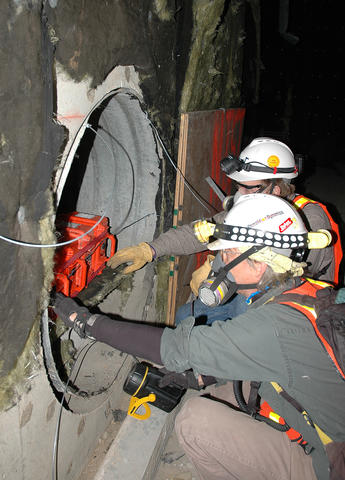
NIST electrical engineers Chris Holloway and Galen Koepke place transmitters in a protected air vent at the old Washington Convention Center prior to the implosion of the building.
Experiments aimed at improving emergency radio communications will be performed by researchers from the Department of Commerce's National Institute of Standards and Technology (NIST) at the old Washington Convention Center in downtown Washington, D.C., before, during and after its demolition on Dec. 18, 2004.
The NIST work, which supports public safety programs of the U.S. departments of Homeland Security and Justice, is intended to help improve the communications capabilities of first responders. First responders who rely on radio communications often lose signals in shielded or complex environments such as the basements or elevator shafts of buildings. It also is very difficult to detect radio signals through the dense rubble of a building that has collapsed as a result of natural disasters or terrorist attacks.
To simulate disaster environments, NIST is using real-world "laboratories"—buildings that are scheduled to be imploded as part of construction and recycling projects. The old Washington Convention Center is among a series of buildings around the country that NIST is using for radio propagation experiments. Among its tasks, NIST is investigating new tools to improve communications, such as methods for detecting very weak radio signals and the use of improvised "antennas" made of metal found in debris to boost signals.
"We're trying to understand the whole radio propagation process in these huge buildings both before and after a collapse," says Chris Holloway, the researcher from NIST's Boulder, Colo., laboratories who is heading up the experiments. "We're specifically looking at very large buildings because that's where you're likely to have communications problems and large numbers of people involved in an emergency situation."
The NIST team will place a set of about 25 battery-operated transmitters at various locations in the convention center prior to demolition. The transmitters send signals near the frequency bands used by emergency personnel and mobile telephones. Scientists will monitor and map the strength of signals sent by the transmitters to receivers outside the building before, during and after the building is imploded. After the implosion, NIST researchers will study various schemes for detecting signals by searching with directional antennas and by connecting detectors to metal debris found within the rubble of the building.
The researchers will be using a variety of techniques, including a method for measuring received signal strength and detecting very weak signals (see at right). NIST researchers hope to develop reliable, cost-effective tools that can be retrofitted to existing radio systems to assist emergency personnel in locating and perhaps communicating with rescuers and other survivors trapped inside a collapsed building. For example, using software that turns sounds into visual images, first responders may be able to receive and see simple patterns—like Morse code—from a survivor repeatedly turning a radio or phone on and off, in cases where the signal was too weak to receive audible voice messages.
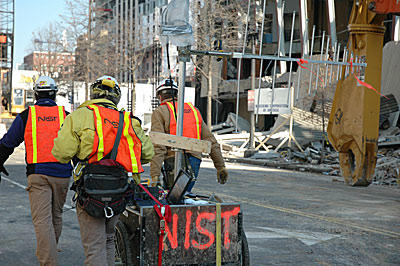
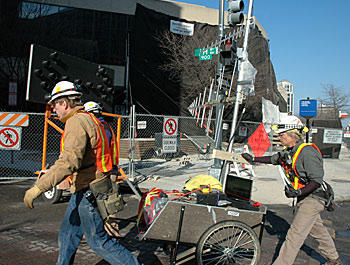
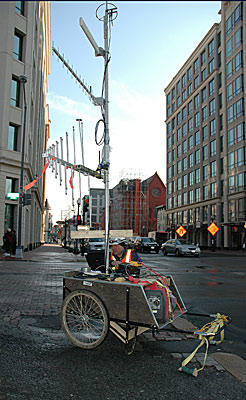
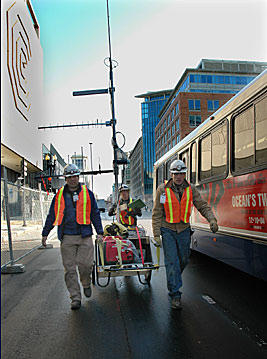
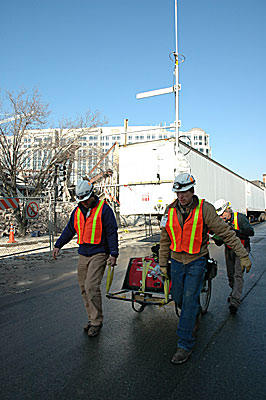
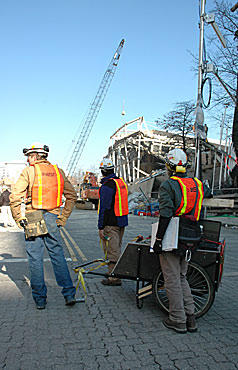
The research is funded in part by the Department of Homeland Security and the Department of Justice's Community Oriented Policing Services.
As a non-regulatory agency of the U.S. Department of Commerce's Technology Administration, NIST develops and promotes measurement, standards and technology to enhance productivity, facilitate trade and improve the quality of life.
For additional information on NIST Emergency Communication projects see this fact sheet.

Background on NIST Radio Propagation Experiments
Other NIST Tests
NIST performed its first set of building implosion experiments at the 13-story Fischer Public Housing Project in New Orleans in January 2004. A second set of experiments was performed at Veterans Stadium in Philadelphia in March 2004. The old Washington Convention Center is the third site in this series.
To complement the implosion experiments, NIST also is performing radio-propagation studies in existing public buildings that will remain standing. This work involves mapping signal strength throughout the buildings to identify potential weak-signal "dead spots" that might hinder emergency rescue efforts. Ultimately, the researchers plan to generate a large set of public-domain data on differences in signal reception at emergency communications frequencies for different types of building environments.
During the week of Nov. 29, 2004, the NIST crew carried out such tests in Maryland in cooperation with the Montgomery County Fire Department. Previous signal-strength mapping tests were performed at an office building in Arizona in May 2004 with members of the Phoenix Fire Department; at a hotel in Colorado Springs, Colo., in June 2004; and at a supermarket in Boulder, Colo., in August 2004.
Detecting Weak Radio Signals
NIST researchers are using a reliable, inexpensive method that improves detection of weak radio signals for first responders in emergency situations. Based on an approach used in deep-space communications, the method may improve signal detection sensitivity by several orders of magnitude over a standard handheld radio receiver.
When a radio signal is weak, a person listening to a radio receiver hears only static but may be able to see the signals if they are converted to a visual display. A visual pattern becomes even easier to see when the signals are confined to a narrow frequency spectrum, as in the NIST application.
The method uses a standard communications receiver to receive a very narrow band of high-frequency radio signals and convert them to lower frequencies. A sound card connected to a personal computer digitizes signals in this band of frequencies. Computer software uses signal-processing techniques to amplify and/or graphically display the digitized signals. The system is calibrated using a new NIST-developed technique, so that the strength of the radio signals can be displayed in absolute units (electric field strength). These calibrated measurements are made possible by NIST laboratory characterizations of antennas and other components. Calibration of the equipment also allows comparison of signal strength measurements made with different receiver systems and may allow manufacturers to verify their product's performance.
The NIST researchers have applied this variety of tools to the specific needs of the public safety community, where systems must be reliable, inexpensive and easy to implement and use in emergency scenarios. The radio receiver is a type already used by many first responders, the sound card is commercially available, and the required audio-recording software is widely available for a nominal charge. In the field, the method could be used to detect faint patterns of data signals (such as Morse code) sent by emergency responders unable to communicate through voice signals. A radio transmitter also might be programmed to emit such signals automatically to help locate a first responder who has collapsed or fallen.

